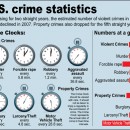PRI Management Group
Print .pdf
Yes, crime stats and UCR are two very different things (more on that in a minute) and now more than ever it’s time to be sure yours are correct. Has the media knocked on your door yet? Have your numbers been called into question even when they were right?
While the accuracy of crime reporting and statistical figures have long been somewhat of an issue in law enforcement, now more so than ever it seems to be of growing concern. The question is why? Is accuracy truly problematic? Is UCR and NIBRS misunderstood? Is the increase in openness and transparency simply leading to more scrutiny? Is Compstat’s ongoing controversy behind it all?
The headlines are everywhere and staying out of them is something you want to do. The leader of the pack right now is the NYPD who is under attack by allegations of manipulated crime data. However, departments large and small are often targets of the media and community watchdogs on the hunt for erroneous statistics. No one is immune.
Criminologists John Eterno and Eli Silverman are spearheading the investigation into the NYPD case. What is worrisome though is the advent of over analysis of this issue involving complicated data crunching and audits conducted by people who claim to be “experts”- people who are really just academia with no real experience in conducting investigations and writing police reports much less putting a UCR report together. Data analysis is certainly key in determining accuracy however, any learned individual who has taken a class in statistics knows how data can be researched, produced, analyzed, and interpreted in different ways, particularly if one doesn’t understand the way crimes are counted under the UCR system. This is why “crime stats” are very different than “UCR” stats (and also why God created crime analysts).
For the simple reason that UCR counts crime according to where it is listed on the UCR hierarchy and whether the incident in question is a persons crime or a property crime, police departments are highly encouraged to keep a second set of numbers which reflect individual or actual numbers of crimes.
According to UCR, persons crimes are counted for each individual victim. Property crimes are counted per incident, regardless of the number of actual victims involved. Having an in-house monthly crime report listing how many actual crimes have occurred, based on state statute and not UCR, reveals exactly how much crime is really going on. This is a report that should be made available to the public (and the media) with a brief explanation of what it represents. This eliminates much of the confusion experienced by those who don’t understand UCR. An example of such an explanation would sound like this:
“UCR is a statistical crime reporting tool that is designed to describe increases and decreases in reportable crime on a national level, not at the local jurisdictional level. It is designed as ‘trend data’ to measure crime in America and only reports certain crimes. This is why we also produce our own departmental statute based crime statistics which provide actual numbers of crimes in our jurisdiction”.
The one day “Crime Stats & UCR for the Police Executive” seminar is a must for those interested in learning about UCR and how to handle those occasions when your agency is called into question for its statistics.
So Why Are Crime Stats Questioned?
It is important to understand that most allegations of manipulated crime statistics are the result of one of two things:
1) Problematic data that is indeed questionable. Why it is questionable is at the core of understanding this growing issue in law enforcement. While the media is prone to believing that intentional efforts are always underway to manipulate crime data to the benefit of the agency in question, this is in fact in most situations not the case. Incorrect data is most often due to problematic report classifications, RMS code table errors, or simple miscalculations. In New York for example, or any other decent sized agency, any notion that systematic and intentional efforts are underway enterprise wide, or by the bosses, to manipulate crime numbers is ludicrous. These kinds of conspiracy theories make headlines. They don’t represent reality. Thanks to public records laws, today’s era of increased transparency, and our systems of checks and balances, intentionally altering crime data is almost an impossibility.
Nonetheless, isolated occurrences of cooking the books by individuals under immense pressure to bring crime down in their area of responsibility have occurred. It seems unfortunately for New York (and the rest of us) that these rare instances (which have been corrected) have painted a very broad and widely publicized picture of law enforcement crookedness.
2) Simple misunderstanding. How crimes are counted under UCR can be downright confusing. Without an understanding of how these systems work, it is easy to assume that an agency’s crime stats are wrong. The FBI’s UCR and NIBRS manuals should be referred to when questions arise. A quick review of the section “how crimes are counted” is a very important read.
7 Steps To Keeping Your Crime Stats Accurate
1) Report Writing. A crime stat starts with a police report. Classifications must be correct.
Quality report writing and thorough training here is key.
2) Quality Control. Reports MUST go through a two-tiered review. After sergeants review
a report, it must then go to records for a second level of review. Sergeants don’t read
reports from a UCR perspective. Records does. The Records unit is the authority on a
department’s crime reporting. If they aren’t, train them and make it happen.
3) Reclassifications. A detective may investigate a crime and have the ability to
reclassify a report to a different crime based on new findings. A system must be in
place wherein all supplements and follow-up investigative reports are reviewed and
approved by a supervisor.
4) Case Clearances. Reports can be cleared by arrest or by exception. The rules by
which ex-clears can be made are strict and must be followed. Case management is
also important here. Whoever in your agency is responsible for changing report
statuses from open to cleared must have a quality assurance system in place to ensure
this is done and done correctly. The media loves to attack clearance rates.
5) Correct Data Capture. RMS systems have code tables, a spreadsheet of sorts that
links report titles, state statutes, and UCR codes together so that these elements are all
reported correctly. These code tables are prone to errors, especially when passed
along from agency to agency as favors. With all the different statutes, subsections, and
UCR codes, there is a lot of room for minor mistakes which can lead to major problems.
6) Compare CFS/UCR Data. Regular comparison of call for service classifications and
UCR classifications can provide insight into any existing problematic data. Wide
variations over extended periods of time between how a call is classified and how it is
written up would indicate the need for further research. While the two data sets
will never align perfectly, they should not include drastic variations. Compare these
numbers on a month to month basis.
7) Surveys. Each month a random list of victims should be compiled. Individuals from
this list should be contacted and surveyed to determine if the report that was written for
his or her case corresponds to the facts as reported by the victim. These surveys
should be conducted by ranking personnel outside the scope or reach of operational
personnel and supervisors, and should be systematically archived. This step is
essential in guarding against intentional downgrading of crimes by supervisors who are
on the hot seat to lower crime.
What are your thoughts on this? Have your agency’s crime stats been called into question?

 0 ITEMS
0 ITEMS
